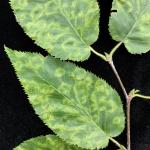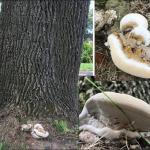UMass Extension's Landscape Message is an educational newsletter intended to inform and guide Massachusetts Green Industry professionals in the management of our collective landscape. Detailed reports from scouts and Extension specialists on growing conditions, pest activity, and cultural practices for the management of woody ornamentals, trees, and turf are regular features. The following issue has been updated to provide timely management information and the latest regional news and environmental data.
To read individual sections of the message, click on the section headings below to expand the content:
Scouting Information by Region
Environmental Data
The following data was collected on or about July 12. Total accumulated growing degree days (GDD) represent the heating units above a 50° F baseline temperature collected via our instruments for the 2017 calendar year. This information is intended for use as a guide for monitoring the developmental stages of pests in your location and planning management strategies accordingly.
|
Region/Location |
GDD |
Soil Temp |
Precipitation |
Time/Date of Readings |
||
|
2-Week Gain |
2017 Total |
Sun |
Shade |
|||
|
Cape Cod |
299 |
998 |
78 |
71 |
4.64 |
12:00 PM 7/12 |
|
Southeast |
377 |
1041 |
76 |
68 |
2.35 |
6:00 PM 7/12 |
|
North Shore |
294 |
1066 |
69 |
66 |
1.43 |
9:00 AM 7/12 |
|
East |
318.5 |
1195 |
75 |
73 |
1.08 |
4:45 PM 7/12 |
|
Metro West |
288.5 |
1101 |
69 |
65 |
1.35 |
5:30 AM 7/12 |
|
Central |
291 |
1112 |
70 |
69 |
0.79 |
8:30 AM 7/12 |
|
Pioneer Valley |
279 |
1103 |
73 |
68 |
1.68 |
10:00 AM 7/12 |
|
Berkshires |
245 |
929 |
68 |
64 |
2.17 |
9:00 AM 7/12 |
|
AVERAGE |
299 |
1068 |
72 |
68 |
1.94 |
- |
|
n/a = information not available |
||||||
Drought Status: All of Massachusetts (100%) is not under official drought status at this time. For more information see http://droughtmonitor.unl.edu/Home/StateDroughtMonitor.aspx?MA
Phenology
| Indicator Plants - Stages of Flowering (BEGIN, BEGIN/FULL, FULL, FULL/END, END) | ||||||||
|---|---|---|---|---|---|---|---|---|
| PLANT NAME (Botanic/ Common) | CAPE | S.E. | N.S. | EAST | METRO W. | CENT. | P.V. | BERK. |
| Buddleia davidii (Butterfly Bush) | Begin | * | Begin/Full | * | Begin/Full | * | * | * |
| Oxydendron arboreum (Sourwood) | Begin | Begin | Full | Begin | Begin/Full | * | * | * |
| Campsis radicans (Trumpet Vine) | Begin/Full | Full | Full | Full | Full | * | Full | Begin |
| Koelreuteria paniculata (Goldenrain Tree) | Begin | * | Full/End | Full/End | * | * | End | * |
| Hydrangea paniculata (Panicle Hydrangea) | Begin | Begin/Full | Begin/Full | Full | Full | Begin | Begin | Begin |
| Hydrangea macrophylla (Bigleaf Hydrangea) | Full | Full | Full | Full/End | Full | Full | Full | Begin |
| Hydrangea arborescens (Smooth Hydrangea) | Full | Full | Full | Full/End | Full | * | Full | Full |
| Itea virginica (Virginia Sweetspire) | Full/End | End | End | * | * | * | End | Full/End |
| Rhus typhina (Staghorn Sumac) | Full/End | Red | Full/End | * | Full | End | Full/End | Full/End |
| Sambucus canadensis (American Elderberry) | Full/End | End | Full/End | * | Full/End | End | End | Full/End |
| * = no activity to report/information not available | ||||||||
Regional Notes
Cape Cod Region (Barnstable)
General Conditions: The average temperature from June 28 - July 12 was 71.5° F with a high of 87° F on July 3 and a low of 53° F on July 6. Temperatures have been primarily in the 70s with a couple days in the 80s during the day. Nighttime temperatures have been primarily in the upper 60s low 70s except for a handful of nights in the lower 60s or high 50s. 4.64 inches of precipitation have fallen during this period, the majority coming on July 7. Over 4 inches of precipitation was recorded in less than 2 hours at the weather station in Barnstable. This precipitation event led to severe flooding and washouts in many areas. Prior to that precipitation event on July 7 soils were very dry, currently topsoil moisture is adequate as is subsoil moisture. During the two weeks relative humidity has been up and down with several days near 100% RH followed by a couple days of drier conditions.
Pests/Problems: Many trees that were defoliated or partially defoliated by gypsy moth have begun to force some new growth. In some areas small numbers of male gypsy moths have been seen over the past week. Oriental, Japanese, and Asiatic beetle are all active. Oriental beetle is the most abundant in most locations on the Cape. Pests seen over the last two weeks include chilli thrips on hydrangea, andromeda lacebug on andromeda, azalea lacebug on PJM rhododendron, viburnum leaf beetle adults on viburnum, four lined plant bug on many species, and boxwood mite on boxwood. Rabbits have been particularly troublesome this year in many Cape locations. Deer flies, black legged nymphs, dog ticks, and mosquitoes are all active Weeds in bloom include; black medic (Medicago lupulina), white clover (Trifolium repens), rabbitfoot clover (Trifolium arvense), hawkweed (Hieracium pratense), red sorrel (Rumex acetosella), goutweed (Aegopodium podagraria), yellow woodsorrel (Oxalis stricta), purslane (Portulaca oleracea), plantain (Plantago lanceolata), prostrate spurge (Euphorbia maculata), Pennsylvania smartweed (Polygonum pennsylvanicum) yellow toad flax (Linaria vulgaris), annual toadflax (Linaria canadensis), sowthisthle (Sonchus oleraceus), Canadian thistle (Cirsium arvense), queen anne's lace (Daucus carota), common milkweed (Asclepias syriaca) .
Southeast Region (Hanson)
General Conditions: Hot, humid (muggy) days and nights, along with the song of annual cicadas, all tell us that the “dog days of summer” are here. Hanson received 2.35 inches of needed rain, as soils were drying out. Defoliated trees have started to put out new secondary foliage. This is a critical time for trees defoliated by caterpillars. Remind clients to be diligent about watering those trees, especially in the absence of rain amounts less than one inch per week. In hot dry weather, the soil around the root systems of those trees may need to be irrigated, deeply, twice per week, to avoid drought stress and subsequent secondary invaders like 2-lined chestnut borer and Armillaria root rot.
The following plants are in full bloom: Stewartia pseudocamellia (Japanese Stewartia), Stewartia ‘Scarlet Sentinel’, Catalpa ovata (Chinese catalpa), Campsis radicans, Hypericum androsaemum ‘Mrs. Gladys Brabazon’, Weston hybrid azaleas, Indigofera sp., Clematis, Roses, Spiraea sp., Hydrangea arborescens (Smooth Hydrangea), Hydrangea quercifolia (Oakleaf hydrangea), Hydrangea macrophylla (mostly lacecaps), Hydrangea paniculata ‘Praecox’, ’ Quick Fire’® and other early cultivars, Rubus odoratus, Lonicera sempervirens, Lonicera ‘John Clayton’, Thermopsis, Lysimachia punctata, Campanula sp., Persicaria polymorpha, Astrantia major, Alchemilla mollis, Rudbeckia sp., Lamium, Asiatic lilies, Heliopsis sp., Platycodon grandiflorus, Asclepias tuberosa, Asclepias syriaca (common milkweed), Actaea (formerly Cimicifuga) racemosa, Shasta daisies, Deinanthe caerulea, Perovskia atriplicifolia, Yucca filamentosa, Astilbe, Liatris spicata, Hollyhocks, Corydalis lutea, daylilies, Hosta, Coreopsis sp., Lysimachia clethroides, Filipendula venusta, Lysimachia ciliata, Monarda didyma (Beebalm) and Spigelia marilandica (Indian Pink). Oxydendrum arboreum (Sourwood Tree), Phlox paniculata and Silphium sp. are beginning bloom. There are still some Kousa dogwoods in bloom; the fruit of Staghorn sumac fruit is red and the “smoke” of Cotinus obovatus (American Smoketree) and Cotinus coggygria (European Smokebush) remain evident. Catalpa bignonioides (Southern Catalpa) is ending bloom.
Hanson is at 1,963 GDD - Growing Degree days, Base 40.
Pests/Problems: Damage to trees from gypsy moth caterpillars was sporadic around the area; however, driving through towns at this time, it is very apparent that some trees were completely defoliated. Gypsy moth caterpillars are done feeding and began pupating in late June – early July. Male gypsy moths began to emerge around July 4th and continue to emerge. Females began to emerge after the males and egg-laying has begun. The insect-attacking fungus, Entomophaga maimaiga, killed massive amounts of late stage caterpillars, however, there are still many surviving females laying eggs for next year. (See Tawny Simisky’s Insect section of the Landscape Message).
Oriental beetles have emerged and are feeding, along with the other night-time feeding Asiatic garden beetle, on a variety of plant material, especially on annuals, perennials and some vegetables. Japanese beetles have also emerged in Hanson and were observed feeding on perennial herbaceous hibiscus.
Sod webworm moths were observed. https://ag.umass.edu/turf/fact-sheets/sod-webworms
Scout and monitor host trees (maple, ash, birch, etc) for Asian longhorned beetles which may begin to emerge in July: https://ag.umass.edu/landscape/fact-sheets/asian-longhorned-beetle
Monitor for perennial hibiscus for Hibiscus sawfly larvae. Bacillus thuringiensis (Bt) does not work on sawfly larvae). Monitor Azaleas for Azalea bark scale, eggs and crawlers.
The following insects remain active: golden tortoise beetle; slugs; snails; earwigs; deer ticks; dog ticks; mosquitoes; European chafer beetles; Asiatic garden beetles, lacebugs on Japanese Andromeda (Pieris japonica), Rhododendron and azaleas; biting flies; White pine sawyer beetle (Asian longhorned beetle look-alike); Hemlock woolly adelgid; elongate hemlock scale; cottony camellia scale on Meserve hollies and Taxus; Fletcher scale on Taxus; Taxus mealybug, earwigs; planthoppers; leafhoppers; stink bugs; mosquitoes; aphids; four-lined plant bugs; lily leaf beetle.
Milkweed, morning glory, nightshade, Linaria vulgaris (Yellow toadflax), Phytolacca americana (Pokeweed), oxeye daisy, Achillea, clover, fleabane and Queen-Anne's-lace continue to bloom and ground ivy, purslane, clearweed and crabgrass are prolific.
Deer and rabbits continue to browse.
North Shore (Beverly)
General Conditions: The last two weeks were hot and humid. Day temperatures were in the mid to high 80s and night temperatures were mostly in the low to mid 70s. We gained 294 growing days during this period, bringing us to total of 1066 growing degree days since the beginning of the year. Approximately 1.43 inches of rainfall was received at Long Hill, Beverly during this reporting period. Most of the rain was received on two days, July 7 and 8. Because of the rains and warm temperatures turf on lawns is growing fast requiring regular mowing. Woody plants seen in bloom include: Oakleaf hydrangea (Hydrangea quercifolia), Big leaf hydrangea (Hydrangea macrophylla), Tree false spirea (Sorbaria arborea), Big leaf dogwood (Cornus macrophylla), Chinese chaste tree (Vitex chinensis), Golden rain tree (Koelreuteria paniculata), Japanese hydrangea vine (Schizophragma hydrangeoides), Sourwood (Oxydendron arboreum) and Lemon drop azalea (Rhododendron ‘Weston’s Lemon Drop’). Herbaceous plants seen in bloom include: Summer flowering roses (Rosa sp.), Clematis vines (Clematis paniculata), Spiderwort (Tradescantia sp.), Water lily (Nymphaea odorata), Hardy cranesbill (Geranium sp.), Ox-eye daisy (Leucanthemum vulgare), Bee balm (Monarda didyma), Hosta (Hosta sp.), Rudbeckia (Rudbeckia fulgida), Daylilies (Hemerocallis sp.), Hostas and Astilbes (Astilbe sp.), Coneflower (Echinacea purpurea), Milkweed (Asclepias syriaca) and Yarrow (Achillea millefolium) . Many annuals are also adding color in the landscape.
Pests/Problems: Cedar-Hawthorn rust (Gymnosporangium globosum) was observed on fruits of single seed hawthorn (Crataegus monogyna). Also observed was powdery mildew on lilac. Marginal leaf scorch continued to be observed on Japanese Stewartia and leaf blotch on peony. Weeds continue to thrive in the landscape. Poison ivy is also thriving so take caution when walking or working in the woods. Remember also that ticks and mosquitoes are still very active. Take measures to protect yourself while working outdoors, especially at dawn or at dusk.
East Region (Boston)
General Conditions: Temperatures during the month of June were seasonal and at historic levels with an average high of 78.8° F, and an average low of 58° F. Rainfall for the month was above average, totaling 4.77 inches compared to 2016 total of 1.22 inches. Moisture continues to be abundant this year and the need for supplemental irrigation has not been necessary so far this summer. Over the last two weeks, we received 1.08 inches of precipitation over four rain events including heavy downpours and thunder on the evening of the 8th. We have gained 318.5 GDDs for a total of 1195 GDDs so far this year. The weather over this time period has been up and down; we experienced numerous perfect summer days with sporadic days of high humidity followed by thundershowers. The highs have ranged from 72° F to 88° F averaging 83° F and the lows have ranged from 52° F to 70° F averaging 62° F. The landscape is lush and green. Summer flowering plants in bloom include: Aesculus parviflora (bottlebrush buckeye), Allium amethystinum 'Red Mohican' (flowering onion), Asclepias syriaca (common milkweed), Campanula spp. (bellflower), Cephalanthus occidentalis (buttonbush), Clethra barbinervis (Japanese clethra), Echinacea purpurea (purple coneflower), Helianthus tuberosus (Jerusalem artichoke), Hydrangea paniculata 'Praecox' (early panicled hydrangea), Hydrangea quercifolia (oakleaf hydrangea), Leucanthemum × superbum (Shasta daisy) and its cultivars, Monarda didyma (scarlet beebalm), Nepeta spp. (catmint), Perovskia atriplicifolia (Russian sage), Rhododendron prunifolium (plumleaf azalea), Sedum spp. (stonecrop), Silphium perfoliatum (cup plant), Stewartia pseudocamellia (Japanese stewartia), Tilia japonica (Japanese linden), Trifolium repens (white clover), Vitex negundo var. heterophylla (Chinese chastetree), and Yucca filamentosa (Adam’s needle). Many pollinators have been observed actively foraging on blooming plants. Wood duck hatchlings have been spotted in the ponds over the last two weeks. Turkey chicks have hatched and are moving around the landscape.
Pests/Problems: Weather conditions have been conducive to rapid growth of unwanted vegetation. Many weeds are flourishing in the landscape including enchanter’s nighshade (Circaea lutetiana), horse nettle (Solanum carolinense), and purple loosestrife (Lythrum salicaria). Fruit continues to ripen on tree of heaven (Ailanthus altissima f. erythrocarpa) and glossy buckthorn (Frangula alnus). Crabgrasses have germinated and are easily spotted in turf areas due to the chartreuse color. Cedar apple rust (Gymnosporangium juniperi-virginianae) is having a banner year and is visible throughout the grounds on many rosaceous species including Amelanchier sp. (serviceberry), Crataegus sp. (hawthorn) and Sorbus sp. (mountain ash). Black spot is prevalent on many rose cultivars. Effects of ambrosia beetle are highly visible throughout the landscape. Aphids can be found in high numbers on many plants throughout the landscape – even on weeds! Their feeding is in its early stages as no sooty mold is yet visible. Adult male gypsy moths have emerged and are starting to fly. Rose curculio weevil (Merhynchites bicolor) is actively feeding on the flowers of white and yellow roses including Rosa ‘Julia Childs’. Mosquitoes are abundant.
Metro West (Acton)
General Conditions: What a difference in weather from last year. As with the past two months, the precipitation measured and recorded for the month of June exceeded the historical monthly average rainfall. The average is 3.93” and 5.03” of rain was recorded last month. This month’s historical monthly average rainfall is 4.07” and 0.88” of rain has been recorded so far this month. Fortunately, the Acton area did not receive the flooding rains that our southern neighbors experienced last Friday on the 7th. Woody plants seen in bloom this past week are: Aesculus parviflora (Bottlebrush Buckeye), Buddleia spp. (Butterfly Bush), Castanea mollissima (Chinese chestnut), Hydrangea arborescens (Smooth Hydrangea), H. paniculata (Panicle Hydrangea), H. quercifolia (Oakleaf Hydrangea), Oxydendron arboreum (Sourwood), Potentilla fruiticosa (Potentilla), Rhus typhina (Staghorn Sumac), Rosa rugosa (Rugosa Rose), R. 'Knockout' (The Knockout family of Roses), Rosa spp. (Rose), Sambucus canadensis (American Elderberry), Spirea japonica 'Alpina' (Daphne Spirea) and Stewartia psuedocamellia (Japanese Stewartia).Woody vines in bloom are: Campsis radicans (Trumpet Vine) and Clematis spp. (Clematis). Contributing even more color and interest to the landscape are some flowering herbaceous plants including: Achillea millefolium (Yarrow), Actaea matsumurae 'White Pearl' (Bugbane), Alcea rosea (Hollyhocks), Asclepias syriaca (Common Milkweed), A. tuberosa (Butterfly Weed), Astilbe spp. (False spirea), Campanula takesimana ‘Elizabeth’ (Bell Flower), C. spp. (Bell Flower), Coreopsis spp. (Tickseed), Daucus carota (Queen Anne's Lace), Echinacea purpurea (Coneflower), Filipendula sp. (Meadow Sweet), Gaillardia aristata (Indian Blanket Flower), Geranium sanguineum (Cranesbill Geranium), Hemerocallis 'Stella D'Oro' (Daylily), H. fulva (Orange Daylily), H. spp. (Daylily), Heuchera spp. (Coral Bells), Hosta spp. (Plantain Lily), Lamium maculatum (Dead Nettle), Leucanthemum sp. (Shasta Daisy), Lilium spp. (Lily), Lychnis coronaria (Rose Campion), Lysimachia clethroides (Gooseneck Loosestrife), Monarda didyma (Bee-Balm), Nepeta spp. (Ornamental Catmint), Oenothera macrocarpa (Ozark Sundrops), Nepeta spp. (Ornamental Catmint), Paeonia spp. (Peony), Penstemon digitalis 'Husker Red' (Beardtongue), Perovskia atriplicifolia (Russian Sage),Rudbeckia fulgida var. sullivantii 'Goldsturm' (Black-eyed Susan), Salvia nemerosa (Salvia), Sedum kamschaticum (Stonecrop), Silene latifolia (White Campion), Stachys byzantina (Lamb’s Ear), Thymus praecox (Thyme), Tradescantia sp. (Spiderwort), Verbena hastata (American Blue Vervain), and Yucca filamentosa (Yucca).
Pests/Problems: Observed in the landscape this past two weeks were gypsy moth caterpillars feeding on Betula nigra (River Birch) and Cedar Apple Rust on Amelanchier sp. (Serviceberry). Setting seed and quite visible is Ailanthus altissima (Tree of Heaven). Look for it growing along roadsides and in parking lots and medians.
Central Region (Boylston)
General Conditions: The weather during this reporting period has been up and down, but temperatures have hovered quite close to historic averages. Periodic showers and hit or miss storms were insufficient during the period so annual planting beds and recent transplants required supplemental irrigation. Among the many plants in bloom now are: Hemerocallis cultivars, Maackia amurensis, Stewartia pseudocamellia, Hydrangea quercifolia, Hydrangea paniculata ‘White Moth’, Yucca filamentosa, Hydrangea serrata ‘Bluebird’, Hydrangea arborescens ‘Annabelle’ and H. arborescens ‘Hayes Starburst’, Stachys officinalis ‘Alba’, Magnolia virginiana, Aesculus parviflora, Cornus kousa, Calycanthus ‘Venus’, Cephalanthus occidentalis, Persicaria polymorpha, Geranium ‘Rozanne’, Nepeta ‘Walker’s Low’ and ‘Junior Walker’, Calluna vulgaris cultivars, Knautia macedonica, many Astilbe cultivars, Actaea racemosa, Alcea rosea, Asclepias syriaca, Hosta cultivars, Callirhoe involucrata, Galtonia viridiflora, Stokesia laevis, Lavender, Achillea millefolium cultivars, Echinacea, Filipendula ulmaria, Tradescantia ‘Sweet Kate’, and many annuals, tender perennials and vegetables are coming into their own.
Pests/Problems. Fire blight strikes in apples and crabapples are ramping up, though less problematic than last year. Japanese Beetles are emerging and showing up on plants throughout the landscape. Asiatic Beetles are also active. Male Gypsy Moths are now in flight. Powdery mildew is showing on Phlox paniculata, and Monarda cultivars. What appears to be a fungal spot is now showing on the flowers of Calycanthus ‘Venus’, marring their beauty. The damage from White Pine Weevil is now apparent in the tips of conifers. Woodchucks are rabbits are especially numerous this year, though voles and chipmunks are not far behind.
Pioneer Valley Region (Amherst)
General Conditions: We’re now firmly in the dog days of summer, with warm temperatures, high humidity and scattered thunderstorms in the Pioneer Valley. We experienced multiple rain events over these past two weeks, but for Hampshire and Hampden Counties, none produced significant rainfall at the time of writing (7/12). Franklin County did receive well over 1″ of rain from a system that moved through on 6/30, but the lack of rainfall south is indicative of the patchiness of storms this time of year. The lack of soaking rain, in combination with seasonal summer temperatures, has led to drying of surface soils. Unirrigated lawns in full sun are browning as they enter dormancy. In shaded areas, growth has slowed dramatically and varying degrees of browning has developed. Subsurface soil moisture remains adequate at this time. Oaks unaffected by defoliating insects had a strong second flush of foliage in recent weeks and appear very robust. However, marginal leaf scorch and branch dieback has developed on many landscape trees over the past month. This decline was likely set in motion by the drought of 2016 and will continue as the season progresses despite the abundant rainfall this season. The landscape has definitely lost its spring luster as we settle into the hottest two months of the year.
Pests/Problems: Japanese, Oriental and Asiatic beetles have now emerged, a bit late this season due to the cooler conditions this spring. While rose is a primary host for Japanese and Oriental beetles, these non-native pests will feed on an array of landscape ornamentals (e.g. oak, elm and phlox) and garden vegetables. Arborvitae leafminer moths have been abundant over the past two weeks. Brushing the canopies of arborvitae can detect the presence of the small, silver-colored moths. Both sycamore and red maple canopies are thickening up as the season progresses. For sycamore, it’s amazing how badly defoliated these trees can remain until conditions become dry and the anthracnose pathogen recedes. The plentiful rain has helped red maples produce additional foliage after this mast year left many with undersized foliage and thin canopies. Tubakia leaf blotch on oak is becoming visible now and will continue to develop through August. Initial symptoms appear as small spots and blotches that will grow in size to consume large sections of leaf area. The pathogen infects in spring when new leaves are developing but symptoms develop later in the season. Many mature American elms in the valley are succumbing to Dutch elm disease (DED), including a truly magnificent tree in Deerfield. This 76″ dbh arboreal leviathan has withstood repeated attacks from DED over the years and despite regular intervention to cull and slow the fungus, the tree was finally overtaken. Damage from the azalea lacebug is widespread and severe in many cases throughout the region. Continue to scout for wood-rotting fungi, especially on oak. Chicken of the wood (Laetiporus sulfureus and L. cincinnatus) may be appearing soon at the base of infected trees. The presence of the fruiting bodies often indicates significant decay at the base of the trunk. For recently transplanted and young white pines suffering from premature needle shedding and needle tip blight, nitrogen fertilization may help them to recover. Late season foliar spots and blights, such as tar spot of maple and entomosporium leaf spot of hawthorn are continuing to become more apparent.
Berkshire Region (Great Barrington)
General Conditions: Temperatures over the past two weeks have matched or been very close to average. With periodic rainfall, soils have remained moist, creating an ideal environment to promote plant growth. Landscapes are for the most part are lush and turfgrass shows no signs of browning or mid-summer dormancy. Pest pressures this year have been low. Many pests which have been problems in recent years have not appeared in great numbers this years. The same cannot be said for foliar diseases which are quite common.
Pests/Problems: Adult Japanese beetles have emerged though the numbers seemingly are not yet at their peak. Asiatic garden beetles are in both pupal and adult stage. During daytime, adult Asiatic garden beetles are commonly encountered by persons weeding or digging in the soil. The adults remain in the soil during the day but emerge at night to feed on foliage and flowers.
Aphids, spittlebugs, spruce spider mite, willow leaf beetle adults and larvae, and lily leaf beetle adults remain active. Magnolia scale is quite visible due to its large size but crawlers are not yet evident. Aphid caused sooty mold is not yet visible but as the populations builds the mold should become evident. Tulip tree (Liriodendron tulipifer) is one tree which has been most affected with aphid infestation and sooty mold development in past years of scouting in this area. The sooty mold develops in the sugary excretion, called honeydew, from the sap sucking aphids.
The deer tick population remains high and reports of tick bites are much too common. Earwigs, sowbugs, snails, mosquitoes, wasps and hornets are also common. Animal browsing in landscapes and gardens can be seen in most settings. Deer, rabbits, woodchucks, and voles seem to be the most common culprits.
As far as plant diseases are concerned, foliar diseases are the most common. Many plants are showing significant defoliation as a result of infections. Roses with black spot, crabapples with apple scab and cedar apple rust, and sycamores with sycamore anthracnose seem to be affected the most. Powdery mildew can be found on ninebark and on lilacs.
Regional Scouting Credits
- CAPE COD REGION - Russell Norton, Horticulture and Agriculture Educator with Cape Cod Cooperative Extension, reporting from Barnstable.
- SOUTHEAST REGION - Deborah Swanson, UMass Extension Horticulturist for Plymouth County - Retired, reporting from Hanson.
- NORTH SHORE REGION - Geoffrey Njue, Green Industry Specialist, UMass Extension, reporting from the Long Hill Reservation, Beverly.
- EAST REGION - Kit Ganshaw & Sue Pfeiffer, Horticulturists, reporting from the Arnold Arboretum, Jamaica Plain.
- METRO WEST REGION – Julie Coop, Forester, Massachusetts Department of Conservation & Recreation, reporting from Acton.
- CENTRAL REGION - Joann Vieira, Superintendent of Horticulture, reporting from the Tower Hill Botanic Garden, Boylston.
- PIONEER VALLEY REGION - Kelly Allen for Nick Brazee, Plant Pathologist, UMass Extension Plant Diagnostic Lab, reporting from UMass Amherst.
- BERKSHIRE REGION - Ron Kujawski, Horticultural Consultant, reporting from Great Barrington.
Woody Ornamentals
Diseases
Recent pests and pathogens of interest seen in the UMass Extension Plant Diagnostic Lab:
Leaf spot of Prunus, caused by Mycosphaerella cerasella, on Prunus kansuensis. Tree is approximately 30-years-old and has been present at the site for 25 years. Numerous brown to purple-colored spots were present on the foliage. While small, they are so numerous they coalesce to create large, necrotic blotches and premature leaf shedding. The fungus can be found on a wide array of ornamental Prunus, but does not appear to be a major foliar pathogen in this region. This disease tends to develop later in the season and management is not often warranted. The tree resides in full sun and is not irrigated.
Anthracnose of crabapple (Malus sp.) caused by Colletotrichum. Several samples representing crabapple trees of varying ages and locations in the landscape. One particular tree is 25-years-old and has been present at the site for 20 years. After a strong flush of growth in the spring, the tree began shedding foliage in late spring / early summer. Angular spots and blotches were observed on the foliage and Colletotrichum was present on the foliage and fruit. The tree resides in full sun in sandy loam soils and is not irrigated. On other samples submitted, the pathogen was present only on the foliage whereas at times, it was also found causing shoot blight and stem cankers.
Hornbeam anthracnose, caused by Apiosporopsis carpinea, on Carpinus laxiflora. Tree is 30-years-old and has been present at the site for nearly as long. The tree had a scattered flush of foliage this spring and the submitted sample had undersized, blighted leaves and dead shoots. Hornbeam anthracnose can be found on Ostrya and Carpinus in this region, mostly attacking the foliage only. In this case, the fungus was also causing a shoot blight and perennial stem cankers. The tree resides in a mass planting of Carpinus and other specimens of the same species also exhibited similar symptoms.
Leaf chlorosis (yellowing) caused by iron deficiency and marginal leaf scorch caused by Colletotrichum on pin oak (Quercus palustris). A large number of nursery trees, three-years-old, developed interveinal chlorosis and a marginal scorch in early June. Trees receive overhead irrigation and reside in full sun. Iron chlorosis is common in pin oak and occurs when soil (or potting media) pH is over 7. When iron is deficient, the leaves cannot produce chlorophyll, leading to chlorosis. Pin oaks naturally occur in floodplains or river bottoms with acidic soils but are generally adaptable to a wide range of sites.
Tubakia leaf blotch, caused by Tubakia dryina and an infestation of the jumping oak gall wasp (Neuroterus saltatorius) on white oak (Quercus alba). The tree is very large and is estimated to be near 100-years-old. It was severely defoliated by gypsy moth in 2016 but was treated in 2017 and suffered only minor injury. The property changed owners recently and turf grass was established around the tree without a mulch ring. The oak resides in a large, open meadow. The defoliation and drought of 2016, along with the turfgrass installation, has weakened the tree and numerous dead branches and stems are present in the canopy. The jumping oak gall was abundant on the submitted foliage, as was Tubakia leaf blotch. The tree may be receiving some supplemental water from irrigation of the turf.
Report by Nick Brazee, Plant Pathologist, UMass Extension Plant Diagnostic Lab, UMass Amherst.
Insects
Woody ornamental insect and non-insect arthropod pests to consider, a selected few:

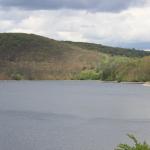
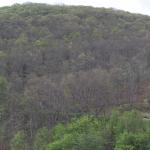
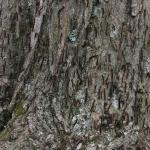

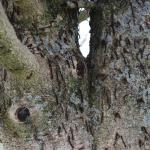 Gypsy Moth: Lymantria dispar has pupated and brown colored, male moths can be seen flying in many locations where gypsy moth was problematic this year. Females are white in color with some black markings with thin, thread-like antennae where males are brown with black markings and plumose or feather-like antennae. Although the females of this species have wings, because our gypsy moths are of European origin, they do not fly (unlike the females of gypsy moths from other locations in the world). The males expertly locate the females and then mate; females are laying fuzzy, brown/tan colored egg masses that will overwinter for the 2018 season. Adult gypsy moth activity is anticipated to be mostly over within the next week, as adults are typically active for a two-week period and male moths were observed by the Elkinton Lab at their research site in Amherst beginning on June 30th. The adult moths of this species do not feed. Management at this time is typically not effective. The young, feeding caterpillars that hatch from these egg masses next spring are the life stage to be targeted for management.
Gypsy Moth: Lymantria dispar has pupated and brown colored, male moths can be seen flying in many locations where gypsy moth was problematic this year. Females are white in color with some black markings with thin, thread-like antennae where males are brown with black markings and plumose or feather-like antennae. Although the females of this species have wings, because our gypsy moths are of European origin, they do not fly (unlike the females of gypsy moths from other locations in the world). The males expertly locate the females and then mate; females are laying fuzzy, brown/tan colored egg masses that will overwinter for the 2018 season. Adult gypsy moth activity is anticipated to be mostly over within the next week, as adults are typically active for a two-week period and male moths were observed by the Elkinton Lab at their research site in Amherst beginning on June 30th. The adult moths of this species do not feed. Management at this time is typically not effective. The young, feeding caterpillars that hatch from these egg masses next spring are the life stage to be targeted for management.
That being said, some have asked about what can be done for the gypsy moth egg masses being laid at this time. Some homeowners take action by scraping egg masses into a can of soapy water (without damaging the bark of the tree). That activity is laborious, time consuming, and limited in its effectiveness mainly because other egg masses (particularly in the surrounding forests or high in the tree canopy and out of reach) are bound to be missed. Do not apply products (such as WD40) to the gypsy moth egg masses that are not specifically labelled for that purpose. (WD40 is not intended nor labelled for that purpose.) Other ideas for management that have been posed to UMass Extension include “what if I burn them off with a blow torch?” UMass Extension does not recommend this for obvious safety reasons, risks to the health of the tree, and again (perhaps least important when compared to the previous two reasons) because of the limits to its effectiveness. Finally, banding trees to capture female moths who may be crawling up them to lay their eggs is also limited in its effectiveness. While some moths may be caught this way, others undoubtedly make their way beyond the band. (Just as the caterpillars were able to do this.)
Many of the trees that were defoliated by gypsy moth caterpillars in 2017 (if they were otherwise healthy) have completely refoliated at this time. Most trees are able to put out a new flush of leaves following defoliation by gypsy moth depending upon tree condition, whether or not they have other biotic and abiotic stressors, and the number and severity of previous defoliations by either gypsy moth or other pests.
Our hope is that most locations in Massachusetts are seeing fewer males and perhaps most importantly fewer female moths, which will lead to fewer egg masses to hatch in 2018. Fewer: that is not to say that these insects will 100% disappear from the landscape next year. However, the hope is that the population will drop below nuisance levels at least in some locations. The Elkinton Lab reports as of 7/12/17, with the exception of one of their research sites in Amherst, Massachusetts that had only seen 44% mortality of gypsy moth caterpillars this season, 98%+ of their sampled caterpillars in 5/10 study sites had perished. The remaining study locations had 87% and 95%+ caterpillar mortality, overall.
This is certainly excellent news, particularly in areas where mortality was above 95%. This is a great indicator that the fungus, Entomophaga maimaiga, was successful in preventing a great percentage of the gypsy moth population (in these study locations) from reaching maturity and therefore contributing to the eggs which will overwinter and provide a population for next season. That being said, locations such as the study site exhibiting only 44% caterpillar mortality in 2017, will undoubtedly see larger gypsy moth populations next year.
Therefore, we rejoice in the fact that the fungus and virus were active in the gypsy moth population this year especially as compared to recent years, but remain cautious. In locations where adults are mating and many egg masses are being laid, anyone with an interest in managing this insect should plan to do so next spring. However, the long-lived resting spores of Entomophaga maimaiga, which are capable of overwintering and providing continued infection of this insect’s population for many years to come, are now present in many areas across the landscape and (as history tells us) the population of gypsy moth will eventually collapse. The question is, and this can depend upon your location in Massachusetts, when will this occur? If you see many brown/tan, fuzzy egg masses being laid again on your trees – you may have to endure gypsy moth caterpillar activity again in 2018.
- Asian Longhorned Beetle, Anoplophora glabripennis, ALB: Look for signs of an ALB infestation which include perfectly round exit holes (about the size of a dime), shallow oval or round scars in the bark where a female has chewed an egg site, or sawdust-like frass (excrement) on the ground nearby host trees or caught in between branches. Be advised that other, native insects may create perfectly round exit holes or sawdust-like frass, which can be confused with signs of ALB activity. Adults of this insect are (historically) active at this time in the regulated area in Massachusetts.
The regulated area for Asian longhorned beetle is 110 miles2 encompassing Worcester, Shrewsbury, Boylston, West Boylston, and parts of Holden and Auburn. If you believe you have seen damage caused by this insect, such as exit holes or egg sites, on susceptible host trees like maple, or have captured an adult beetle that you believe to be ALB, please call the Asian Longhorned Beetle Eradication Program office in Worcester, MA at 508-852-8090 or toll free at 1-866-702-9938.
To report an Asian longhorned beetle find online or compare it to common insect look-alikes, visit: http://massnrc.org/pests/albreport.aspx or https://www.aphis.usda.gov/pests-diseases/alb/report.
- White Spotted Pine Sawyer (WSPS): Monochamus scutellatus adults will continue to be active through July. This is a native insect in Massachusetts and is usually not a pest. Larvae develop in weakened or recently dead conifers, particularly eastern white pine (Pinus strobus). However, the white spotted pine sawyer looks very similar to the invasive Asian Longhorned Beetle, Anoplophora glabripennis, ALB. ALB adults emerge in Massachusetts in July and August. Now is the time to look for the key difference between WSPS and ALB adults, which is a white spot in the top center of the wing covers (the scutellum) on the back of the beetle. White spotted pine sawyer will have this white spot, whereas Asian longhorned beetle will not. Both insects can have other white spots on the rest of their wing covers; however, the difference in the color of the scutellum is a key characteristic (ALB’s is black). See the Asian longhorned beetle entry above for more information about that non-native insect.
- Asiatic Garden Beetle: Maladera castanea adults are active and are typically most abundant in July and August. These rusty-red colored beetles are bullet-shaped and active at night. They are often attracted to porch lights. They feed on a number of ornamental plants, defoliating leaves by giving the edges a ragged appearance and also feeding on blossoms. Butterfly bush, rose, dahlia, aster, and chrysanthemum can be favored hosts. When levels of damage reach a management threshold, pyrethroid- based insecticides may be necessary. Read and follow label instructions and avoid harming non-target organisms. Certain neem oil products are also labelled for use against adult beetles. Observe label instructions to minimize the potential for leaf injury.
- Black Vine Weevil: Otiorhynchus sulcatus damage is apparent on rhododendron and taxus, but can also be seen on azalea, mountain laurel, and Euonymus. Adult weevils feed along the leaf/needle margins and create rounded notches. Inspect foliage of these plants for notching from last season’s feeding. Adults emerged in June and create new damage to leaves for this season. All individuals are females and reproduce asexually. This insect has developed resistance to many chemical insecticides. Entomopathogenic nematodes such as Steinernema carpocapsae, S. feltiae, and Heterorhabditis bacterio-phora work well against this insect, particularly on containerized plants. Results in the landscape vary. Wetting the soil thoroughly prior to application and keeping it wet for at least 5 days following application can help increase the efficacy of the nematodes. Burlap laid around the base of plants during the time adults are active, through August, can be inspected weekly for adult weevils which can be killed before egg laying.
- Cottony Taxus Scale: Chloropulvinaria floccifera, also referred to as the cottony camellia scale, utilizes such hosts as taxus, camellia, holly, hydrangea, Japanese maple, euonymus, magnolia, jasmine, and Callicarpa americana. This insect was observed on taxus in Amherst on 5/31/17. Females are laying the long, narrow, white colored egg sac that makes them much more noticeable. This was observed again on 6/8/17 and 6/14/17. Eggs will hatch over an extended period of 6 weeks and crawlers may be treated between 802-1388 GDD’s. This insect can cause the host to appear off-color. They also produce honeydew which promotes sooty mold growth. Target the underside of the foliage. Horticultural oil, neem oil, and insecticidal soaps may be used to manage these soft scales. They may also be washed from plants with a strong jet of water.
- Elongate Hemlock Scale: Fiorinia externa is found on eastern, Carolina, and Japanese hemlock, as well as yew, spruce, and fir. Crawlers will be present throughout the growing season and the overlap of many developmental stages at any given time can be observed.
- Emerald Ash Borer (EAB): Agrilus planipennis readily attacks ash (Fraxinus spp.) including white, green, and black ash and has also been found developing in white fringe tree (Chionanthus virginicus) and most recently, cultivated olive (Olea europaea). (See: https://academic.oup.com/jee/article-lookup/doi/10.1093/jee/tox139) Adult insects of this species are active. Signs of an EAB infested tree may include D-shaped exit holes in the bark, “blonding” or lighter coloration of the ash bark from woodpecker feeding (chipping away of the bark as they search for larvae beneath), and serpentine galleries visible through splits in/upon peeling the bark, from larval feeding beneath. Positive identification of an EAB-infested tree may not be possible with these signs individually on their own.
For a map of the known locations of emerald ash borer in the state, as well as further information about this insect, please visit: https://ag.umass.edu/fact-sheets/emerald-ash-borer. If you believe you have located EAB-infested ash trees, particularly in an area of Massachusetts not identified on the map provided, please report it at the Massachusetts Introduced Pests Outreach Project: http://massnrc.org/pests/pestreports.htm.


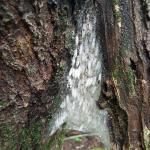
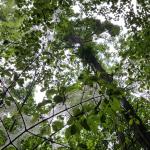

 Euonymus Caterpillar (Spindle Ermine Moth): Yponomeuta cagnagella is of European origin and widespread in distribution throughout Europe. It was first reported in North America in Ontario in 1967. As of 7/13/17, adult moths are present at a location in Amherst, MA. Management is not necessary or possible at this time in the season. Many spent pupal cases (cocoons) remain in the area, along with leftover webbing from the caterpillar activity that has now passed for 2017. The euonymus caterpillars (larvae) feed in groups and envelop the foliage of the host plant in webs as they feed. Hosts include: Euonymus europaeus (tree form), E. kiautschovicus, E. alatus, and E. japonicus. Adult moths are still present at this time and females will lay eggs on twigs, branches, and near buds on hosts. The female secretes a gummy substance over the eggs which will harden, making them even more difficult to see. Eggs hatch by mid-August, at which time the tiny larvae prepare to overwinter beneath their eggshell-like covering. These larvae are inactive until the following year, when caterpillars group together to feed on newly emerging leaves, creating a mess of webs as they feed. Mature caterpillars are just under an inch in length, creamy yellow-gray in color with black spots and a black head capsule. By late June, these larvae pupate in white, oval-shaped cocoons which are typically oriented together vertically either on host plants or non-hosts in the area. Cocoons can be found in cracks and crevices, or webbed together leaves. The adult emerges in late June in most locations. Adults were observed at a location in Amherst on 7/7/17 and 7/13/17. There is one generation per year. Plants may be partially or entirely defoliated, but (as was observed this season at this location in Amherst) they are capable of refoliating in the same season. Management of young, actively feeding caterpillars with Bacillus thuringiensis is possible if deemed necessary.
Euonymus Caterpillar (Spindle Ermine Moth): Yponomeuta cagnagella is of European origin and widespread in distribution throughout Europe. It was first reported in North America in Ontario in 1967. As of 7/13/17, adult moths are present at a location in Amherst, MA. Management is not necessary or possible at this time in the season. Many spent pupal cases (cocoons) remain in the area, along with leftover webbing from the caterpillar activity that has now passed for 2017. The euonymus caterpillars (larvae) feed in groups and envelop the foliage of the host plant in webs as they feed. Hosts include: Euonymus europaeus (tree form), E. kiautschovicus, E. alatus, and E. japonicus. Adult moths are still present at this time and females will lay eggs on twigs, branches, and near buds on hosts. The female secretes a gummy substance over the eggs which will harden, making them even more difficult to see. Eggs hatch by mid-August, at which time the tiny larvae prepare to overwinter beneath their eggshell-like covering. These larvae are inactive until the following year, when caterpillars group together to feed on newly emerging leaves, creating a mess of webs as they feed. Mature caterpillars are just under an inch in length, creamy yellow-gray in color with black spots and a black head capsule. By late June, these larvae pupate in white, oval-shaped cocoons which are typically oriented together vertically either on host plants or non-hosts in the area. Cocoons can be found in cracks and crevices, or webbed together leaves. The adult emerges in late June in most locations. Adults were observed at a location in Amherst on 7/7/17 and 7/13/17. There is one generation per year. Plants may be partially or entirely defoliated, but (as was observed this season at this location in Amherst) they are capable of refoliating in the same season. Management of young, actively feeding caterpillars with Bacillus thuringiensis is possible if deemed necessary.- Fall Webworm: Hyphantria cunea is native to North America and Mexico. It is now considered a worldwide pest, as it has spread throughout much of Europe and Asia. (For example, it was introduced accidentally into Hungary from North America in the 1940’s.) Hosts include nearly all shade, fruit, and ornamental trees except conifers. In the USA, at least 88 species of trees are hosts for these insects, while in Europe at least 230 species are impacted. In the past history of this pest, it was once thought that the fall webworm was a two-species complex. It is now thought that H. cunea has two color morphs – one black headed and one red headed. These two color forms differ not only in the coloration of the caterpillars and the adults, but also in their behaviors. Caterpillars may go through at least 11 molts, each stage occurring within a silken web they produce over the host. When alarmed, all caterpillars in the group will move in unison in jerking motions that may be a mechanism for self-defense. Depending upon the location and climate, 1-4 generations of fall webworm can occur per year. Fall webworm adult moths lay eggs on the underside of the leaves of host plants in the spring. These eggs hatch in late June or July depending on climate. Young larvae feed together in groups on the undersides of leaves, first skeletonizing the leaf and then enveloping other leaves and eventually entire branches within their webs. Webs are typically found on the terminal ends of branches. All caterpillar activity occurs within this tent, which becomes filled with leaf fragments, cast skins, and frass. Fully grown larvae then wander from the webs and pupate in protected areas such as the leaf litter where they will remain for the winter. Adult fall webworm moths emerge the following spring/early summer to start the cycle over again. 50+ species of parasites and 36+ species of predators are known to attack fall webworm in North America. Fall webworms typically do not cause extensive damage to their hosts. Nests may be an aesthetic issue for some. If in reach, small fall webworm webs may be pruned out of trees and shrubs and destroyed. Do not set fire to H. cunea webs when they are still attached to the host plant.
- Fletcher Scale: Parthenolecanium fletcheri (soft scale) was observed on taxus (yew) in Amherst on 6/8/17 and 6/14/17. Several effective parasites will impact these scale populations and any management decisions should seek to preserve them. This scale is commonly found on yew and arborvitae (but has also been reported on juniper and hemlock). It may be confused with the European fruit lecanium (P. corni), which has a much broader host range. Depending upon the host plant, crawlers of the fletcher scale hatched by the end of June and management may be targeted between 1029-1388 GDD’s, base 50°F. Crawlers were observed beneath a single desiccated female sampled on 6/29/17 from Taxus in Amherst, MA. Large populations of this scale may lead to host plant yellowing, premature needle drop, and production of honeydew giving way for sooty mold. Each female produces on average 500-600 eggs. The degree of impact this insect may have depends on the host. Some hosts, such as yew, are reportedly more heavily impacted by this scale as when compared to arborvitae, where visible damage may be seldom. Horticultural oil, insecticidal soap, or neem oil may be used according to label instructions in order to preserve natural enemies.

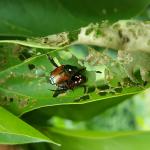 Japanese Beetles:Popillia japonica adult beetles were first reported as active in Massachusetts the week of June 23rd this year and continue to be spotted across the landscape. Adult female beetles will lay their eggs primarily by early August, however eggs may be laid into September. Females lay these eggs in groups in soil cavities they excavate 2-4 inches down. Japanese beetles overwinter as nearly grown grubs in the soil which are capable of evading freezing behaviorally by moving below the frost line. As soils warm in the spring, larvae become active and feed on the roots of grasses. Pupation occurs 1-3 feet below the soil surface. Adults emerge from these lawn areas and disperse to feed on foliage, mate, and return to turf-type locations for females to lay their eggs. Japanese beetle adults use aggregation pheromones (chemicals that signal between individuals) to call in others of the same species. These pheromones and volatile chemicals from host plants being fed upon are thought to be the reason why large numbers of these beetles can be found feeding together. Adult beetles feed on foliage and flowers, often skeletonizing leaves until they appear lace-like. Larvae are highly damaging turf pests. Tree and shrub hosts are comprised of more than 300 species including but not limited to rose, mountain-ash, willow, linden, elm, Japanese and Norway maples, birch, sycamore, rose of Sharon, ornamental apple, and many others. Adult beetles are often attracted to feeding on sunny areas of the plant. Pheromone traps for this insect have not been found to be effective at lowering populations, and research suggests they may draw in more beetles to any host plants within the vicinity of the trap. Many organisms are parasitoids of Japanese beetles, such as two wasps that attack overwintered grubs in the spring, and a tachinid fly (winsome fly: Isocheta aldrichi) which parasitizes newly emerged adult beetles. Other organisms act as generalist predators with Japanese beetles on their menus, including but not limited to ants, certain other beetles, small mammals, and birds.
Japanese Beetles:Popillia japonica adult beetles were first reported as active in Massachusetts the week of June 23rd this year and continue to be spotted across the landscape. Adult female beetles will lay their eggs primarily by early August, however eggs may be laid into September. Females lay these eggs in groups in soil cavities they excavate 2-4 inches down. Japanese beetles overwinter as nearly grown grubs in the soil which are capable of evading freezing behaviorally by moving below the frost line. As soils warm in the spring, larvae become active and feed on the roots of grasses. Pupation occurs 1-3 feet below the soil surface. Adults emerge from these lawn areas and disperse to feed on foliage, mate, and return to turf-type locations for females to lay their eggs. Japanese beetle adults use aggregation pheromones (chemicals that signal between individuals) to call in others of the same species. These pheromones and volatile chemicals from host plants being fed upon are thought to be the reason why large numbers of these beetles can be found feeding together. Adult beetles feed on foliage and flowers, often skeletonizing leaves until they appear lace-like. Larvae are highly damaging turf pests. Tree and shrub hosts are comprised of more than 300 species including but not limited to rose, mountain-ash, willow, linden, elm, Japanese and Norway maples, birch, sycamore, rose of Sharon, ornamental apple, and many others. Adult beetles are often attracted to feeding on sunny areas of the plant. Pheromone traps for this insect have not been found to be effective at lowering populations, and research suggests they may draw in more beetles to any host plants within the vicinity of the trap. Many organisms are parasitoids of Japanese beetles, such as two wasps that attack overwintered grubs in the spring, and a tachinid fly (winsome fly: Isocheta aldrichi) which parasitizes newly emerged adult beetles. Other organisms act as generalist predators with Japanese beetles on their menus, including but not limited to ants, certain other beetles, small mammals, and birds.
 Jumping Oak Gall Wasp: Neurotus saltatorius is a species of cynipid gall wasp known as the jumping oak gall wasp. This wasp has been known to the northwestern and Midwestern United States, but reports of this insect’s activity exist in New York from 1891. This tiny wasp makes seed-like galls on the underside of oak leaves, which eventually drop to the ground. These galls can “jump” once they land on the ground until they rest in a protected spot. Hosts include white oak. Each gall contains a single larva. Adults emerge from galls in the spring and lay eggs near opening buds. These insects are not injurious to the host and therefore management is not necessary.
Jumping Oak Gall Wasp: Neurotus saltatorius is a species of cynipid gall wasp known as the jumping oak gall wasp. This wasp has been known to the northwestern and Midwestern United States, but reports of this insect’s activity exist in New York from 1891. This tiny wasp makes seed-like galls on the underside of oak leaves, which eventually drop to the ground. These galls can “jump” once they land on the ground until they rest in a protected spot. Hosts include white oak. Each gall contains a single larva. Adults emerge from galls in the spring and lay eggs near opening buds. These insects are not injurious to the host and therefore management is not necessary.- Lace Bugs: Corythucha spp. and Stephanitis spp. lace bugs are active. Corythucha spp. utilize many hosts such as: hawthorn, cotoneaster, amelanchier, quince, pyracantha, various oaks, birch, maple, mountain ash, sycamore, hackberry, elm, walnut, butternut, basswood, etc. By the time we reach 1266-1544 GDD’s, management of Corythuca spp. may be necessary again if these insects were problematic earlier this season. Stephanitis spp. lacebugs such as S. pyriodes can cause severe injury to azalea foliage. S. rhododendri can be common on rhododendron and mountain laurel. S. takeyai has been found developing on Japanese andromeda, leucothoe, styrax, and willow. Stephanitis spp. lace bugs should be monitored through September. Before populations become too large, treat with a summer rate horticultural oil spray as needed. Be sure to target the undersides of the foliage in order to get proper coverage of the insects. Fall or early spring soil treatment with imidacloprid has been effective, but be aware of the implications this may have on pollinators attracted to these flowering plants when making management decisions. Certain azalea and andromeda cultivars may be less preferred by lace bugs.
 Lily Leaf Beetle: Lilioceris lilii adult beetles were nowhere to be seen on 7/12/17 at a location in Amherst, MA where observations have been made all season. On this same date, only a single frass-covered larva was found feeding on the plants in question. Larvae can feed for 16-24 days and then drop to the soil to pupate. Adults will emerge 16-22 days later and are then seen feeding throughout the remainder of the growing season. Adults will overwinter. Management can be achieved by hand-picking and removing adults and larvae. Some chemical management options are available for this insect, but if caught early mechanical management may be effective. (Although when many plants are involved, mechanical management may not be practical.)
Lily Leaf Beetle: Lilioceris lilii adult beetles were nowhere to be seen on 7/12/17 at a location in Amherst, MA where observations have been made all season. On this same date, only a single frass-covered larva was found feeding on the plants in question. Larvae can feed for 16-24 days and then drop to the soil to pupate. Adults will emerge 16-22 days later and are then seen feeding throughout the remainder of the growing season. Adults will overwinter. Management can be achieved by hand-picking and removing adults and larvae. Some chemical management options are available for this insect, but if caught early mechanical management may be effective. (Although when many plants are involved, mechanical management may not be practical.)
The University of Rhode Island Biological Control Lab is researching ways to find a natural method to combat these beetles. Small parasitic insects have been established in lily plots in Cumberland, RI and Wellesley, MA in hopes that these insects will disperse naturally to reduce the effects of the lily leaf beetle. If you have larvae in your yard (or a customer’s yard), please send to URI, following the instructions on the URI Biocontrol Lab website: http://web.uri.edu/biocontrol/home/lily-leaf-beetle-larval-collections-2016-mailing-instructions/
- Roseslugs: These small, caterpillar-like sawfly larvae will skeletonize the upper leaf surface and leave a “window-pane” like pattern behind. When present in large numbers, these insects are capable of defoliating their entire host. Management options include an insecticidal soap spray or a product containing spinosad. One species, Allantus cinctus, may require management again in mid-August; otherwise the window for management passes typically by mid-June.
 Two-marked Tree Hopper: The Enchenopa binotata species complex is now thought to be made up of very closely related Enchenopa spp. that are morphologically very similar but separated by the different host plants that they are found on. These particular treehoppers are found on black walnut, wafer ash (Ptelea trifoliata), and viburnum. These insects will feed on the host plants with piercing-sucking mouthparts and drink plant juices from the leaves and petioles. Leaves will become shiny and sticky with their excrement. Some nymphs are still present, but mostly adults of this insect were observed on wafer ash in Amherst on 7/12/17. Eggs will be laid by adult females using saw-like ovipositors to insert them into plant stems. (This has not yet been observed at this location.) Eggs are then covered with a vivid white, sticky, frothy material that protects them but can easily be mistaken for a scale insect. These treehoppers, whether by their feeding activity or egg laying behavior into plant stems, are not considered to be damaging pests (even when high in numbers) and therefore management is generally not required.
Two-marked Tree Hopper: The Enchenopa binotata species complex is now thought to be made up of very closely related Enchenopa spp. that are morphologically very similar but separated by the different host plants that they are found on. These particular treehoppers are found on black walnut, wafer ash (Ptelea trifoliata), and viburnum. These insects will feed on the host plants with piercing-sucking mouthparts and drink plant juices from the leaves and petioles. Leaves will become shiny and sticky with their excrement. Some nymphs are still present, but mostly adults of this insect were observed on wafer ash in Amherst on 7/12/17. Eggs will be laid by adult females using saw-like ovipositors to insert them into plant stems. (This has not yet been observed at this location.) Eggs are then covered with a vivid white, sticky, frothy material that protects them but can easily be mistaken for a scale insect. These treehoppers, whether by their feeding activity or egg laying behavior into plant stems, are not considered to be damaging pests (even when high in numbers) and therefore management is generally not required.- Viburnum Leaf Beetle: Pyrrhalta viburni is a beetle in the family Chrysomelidae that is native to Europe, but was found in Massachusetts in 2004. See the Regional Reports regarding areas where this insect has been noted to be active this season. Adult beetles have been spotted by scouts in the Cape Cod Region and are expected to be active roughly through October, or when the first frost hits. Adult beetles will create their own feeding damage, but will also mate and females will lay eggs in the stems of the viburnums, typically beginning in late-June to mid-July until October. This beetle feeds exclusively on many different species of viburnum including but not limited to susceptible plants such as V. dentatum, V. nudum, V. opulus, V. propinquum, and V. rafinesquianum. Some viburnum have been observed to have varying levels of resistance to this insect, including but not limited to V. bodnantense, V. carlesii, V. davidii, V. plicatum, V. rhytidophyllum, V. setigerum, and V. sieboldii. More information about viburnum leaf beetle may be found at http://www.hort.cornell.edu/vlb/.
- Chilli Thrips: The non-native, exotic chilli thrips (Scirtothrips dorsalis) has been confirmed from two samples of damaged Hydrangea spp. foliage from two residential landscapes located in Barnstable County, MA submitted to the UMass Plant Diagnostics Laboratory. At this time, this pest has not been confirmed in nurseries or greenhouses in Massachusetts or on any other host plants. Due to the limited number of samples, the significance of chilli thrips in Massachusetts is not yet known. This species of thrips is a significant global pest of economically important ornamental, vegetable, and fruit crops in southern and eastern Asia, Oceania, and parts of Africa. It was first determined to be established in the United States in 2005 in Florida, although previous interceptions of this pest were detected. It is reportedly a pest of over 100 host plants belonging to over 40 plant families, including, but not limited to, pepper, strawberry, blueberry, cotton, rose, peanut, Japanese privet, Rhododendron spp., Viburnum spp., eggplant, grapes, melon, tobacco, and tomato. For more information, please visit this Chilli Thrips Fact Sheet (https://ag.umass.edu/landscape/fact-sheets/chilli-thrips) available on the UMass Extension Landscape, Nursery, and Urban Forestry Program web page.
Concerned that you may have found an invasive insect or suspicious damage caused by one? Need to report a pest sighting? If so, please visit the Massachusetts Introduced Pests Outreach Project: http://massnrc.org/pests/pestreports.htm.
Pollinator Protection Resource Online: The Massachusetts Department of Agricultural Resources has developed a Massachusetts Pollinator Protection Plan. It is a set of voluntary guidelines that discuss best management practices for stakeholders seeking to promote the health of the European honeybee and other pollinators. This document includes information for beekeepers, pesticide applicators, land managers and farmers, nurseries and landscapers, and homeowners and gardeners. Please locate the MA Pollinator Protection Plan for more information here: http://www.mass.gov/eea/docs/agr/farmproducts/apiary/pollinator-plan.pdf.
A note about Tick Awareness: deer ticks (Ixodes scapularis), the American dog tick (Dermacentor variabilis), and the lone star tick (Amblyomma americanum) are all found throughout Massachusetts. Each can carry their own complement of diseases. Anyone working in tick habitats (wood-line areas, forested areas, and landscaped areas with ground cover) should check themselves regularly for ticks while practicing preventative measures. Have a tick and need it tested? Visit the web page of the UMass Laboratory of Medical Zoology (https://www.tickreport.com/) and click on the red Test a Tick button for more information.
- For information about protecting yourself from ticks and tick-borne diseases, please visit: https://ag.umass.edu/landscape/fact-sheets/information-regarding-ticks-tick-borne-diseases.
- For information about managing ticks in landscapes, among other topics, please visit the following publication from the Connecticut Agricultural Experiment Station: “Tick Management Handbook”: http://www.ct.gov/caes/lib/caes/documents/publications/bulletins/b1010.pdf.
Management Practices
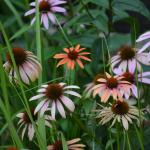
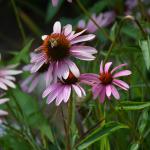


 Plant of the week: Echinacea purpurea, purple coneflower
Plant of the week: Echinacea purpurea, purple coneflower
Echinacea purpurea is a great North American native. This clumping herbaceous perennial grows 2-5’ tall and spreads 1.5-2’ The pink-purple daisy like flowers bloom thought the summer. Leaves are dark green, ovate, and rough-hairy. Appearance is best if spent flowers are removed, this also encourages rebloom as well as limits self-seeding. This adaptable plant grows best in dry to medium soil in full sun to part shade. Plants are tolerant of drought, deer, heat, and humidity. Japanese beetle and leaf spot can be problems. Purple coneflower is a great choice for perennial and wildflower gardens, meadows, borders, native and naturalized areas, pollinator gardens, and cut flower gardens. There are numerous cultivars which offer pink, orange, white, yellow, peach, or green flowers, double flowers, drooping petals, and smaller sizes.
Report by Mandy Bayer, Extension Assistant Professor of Sustainable Landscape Horticulture, UMass Stockbridge School of Agriculture
Additional Resources
To receive immediate notification when the next Landscape Message update is posted, be sure to join our e-mail list and follow us on Facebook and Twitter.
For a complete listing of upcoming events, see our Upcoming Educational Events page.
For commercial growers of greenhouse crops and flowers - Check out the New England Greenhouse Update website
For professional turf managers - Check out Turf Management Updates
For home gardeners and garden retailers - Check out home lawn and garden resources. UMass Extension also has a Twitter feed that provides timely, daily gardening tips, sunrise and sunset times to home gardeners, see https://twitter.com/UMassGardenClip
Diagnostic Services
A UMass Laboratory Diagnoses Landscape and Turf Problems - The UMass Extension Plant Diagnostic Lab is available to serve commercial landscape contractors, turf managers, arborists, nurseries and other green industry professionals. It provides woody plant and turf disease analysis, woody plant and turf insect identification, turfgrass identification, weed identification, and offers a report of pest management strategies that are research based, economically sound and environmentally appropriate for the situation. Accurate diagnosis for a turf or landscape problem can often eliminate or reduce the need for pesticide use. For sampling procedures, detailed submission instructions and a list of fees, see Plant Diagnostics Laboratory
Soil and Plant Nutrient Testing - The University of Massachusetts Soil and Plant Nutrient Testing Laboratory is located on the campus of The University of Massachusetts at Amherst. Testing services are available to all. The function of the Soil and Plant Nutrient Testing Laboratory is to provide test results and recommendations that lead to the wise and economical use of soils and soil amendments. For complete information, visit the UMass Soil and Plant Nutrient Testing Laboratory web site. Alternatively, call the lab at (413) 545-2311.
Ticks are active at this time! Remember to take appropriate precautions when working and playing outdoors, and conduct daily tick checks. UMass tests ticks for the presence of Lyme disease and other disease pathogens. Learn more
